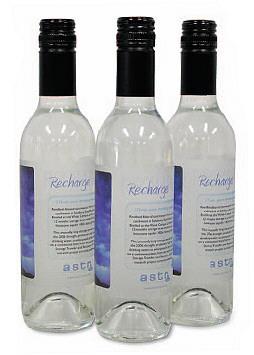Posted 5 September 2007

The bottled product as presented to the Prime Minister for taste testing (CSIRO)
A team of Adelaide researchers has combined the potential of stormwater and underground aquifers with some marketing nous to create a drinking water 'product' that, according to our Prime Minister, passes the taste test.
Researchers from CSIRO Land and Water and Water for a Healthy Country Flagship collected and bottled the water from an aquifer storage and recovery scheme in the South Australian city of Salisbury. CSIRO says this is the first time that urban stormwater has been bottled as drinking water.
Prime Minister John Howard and Environment and Water Resources Minister Malcolm Turnbull were among the first to drink the water at a meeting of the Prime Minister's Science, Engineering and Innovation Council in Canberra in June.
The bottling aimed to demonstrate the effectiveness of the Aquifer Storage Transfer and Recovery (ASTR) project, a unique concept which involves CSIRO, United Water, the City of Salisbury, SA Water and the SA Department of Water, Land and Biodiversity Conservation.
The bottled water began as urban stormwater from Salisbury, treated first via a reed bed then stored in a limestone aquifer for 12 months. The aquifer storage time was extended due to the 2006 drought.
The recovered water at the time of bottling contained 93 per cent stormwater from 2005 and 7 per cent brackish native groundwater, estimated to be 10 000 years old. It was rigorously tested and met all drinking water criteria.
CSIRO says the ASTR demonstration project will involve about 200 000 m3 of urban stormwater being harvested each year via the same reed bed and injected into an aquifer to improve quality, before it is recovered from separate wells at drinking water standards.
Four 160 to 180-metre deep wells are used to inject the reedbed-treated stormwater into the aquifer, and another two wells are used to recover the water
after it has travelled 50 metres through the aquifer.
The research focuses on water quality improvements to the treated stormwater. This includes studies on the attenuation of pathogens and organics, physical and biogeochemical processes and the development and implementation of a Hazard
Analysis and Critical Control Points (HACCP) approach to provide water quality assurance over the long term. The approach is consistent with current Australian Drinking Water potable water guidelines.
CSIRO research leader Dr Peter Dillon says the project aims to demonstrate that potable and nonpotable supplies can be sourced from stormwater that currently flows to the sea. If the ASTR project is successful, the concept could be replicated elsewhere, including overseas.
'The bottled water clearly shows the potential for this water to go into mains supplies,' he says. 'Further research is required to validate this and build confidence in this approach.'
According to the National Water Commission's Dr John Radcliffe, establishing that naturally purified stormwater could be stored underground in suitable geological structures as a new source of drinking water when needed is an important development for Australia.
The demonstration trial is the result of collaboration between partners from research institutes, local, state and federal government departments and private industry.
The project was recently recognised at the SA Water Industry Alliance Awards, with project partner United Water winning the collaboration category.
Dr Rudi Regel, ASTR Project Manager from United Water, says the ASTR demonstration trial is one of eight case study sites for the international Reclaim Water project, funded by the European Union and involving 19 partners from western and eastern Europe, Israel, China, Mexico, South Africa and Singapore.
'Involvement in the Reclaim Water project is not only advancing science, but also providing CSIRO and ASTR project partners the chance to showcase their expertise, build new relationships and develop future research projects,' he says.
Links:
Reproduced from ECOS 138 Aug-Sep 2007, www.publish.csiro.au/ecos.

Professor Andy Baker features in American Water Resources Association ‘Water Resources Impact’, September 2020 edition.

The Connected Waters Initiative (CWI) is pleased to welcome Taylor Coyne to its network as a postgraduate researcher. If you’re engaged in research at a postgraduate level, and you’re interested in joining the CWI network, get in touch! The CWI network includes multidisciplinary researchers across the Schools of Engineering, Sciences, Humanities and Languages and Law.

The Grand Challenge on Rapid Urbanisation will establish Think Deep Australia, led by Dr Marilu Melo Zurita, to explore how we can use our urban underground spaces for community benefit.

On the 21 August 2020, CWI researchers made a submission to the National Water Reform Inquiry, identifying priority areas and making a number of recommendations as to how to achieve a sustainable groundwater future for Australia.

Results published from a research project between the Land Development Department (LDD) Thailand and UNSW has demonstrated how 2-dimensional mapping can be used to understand soil salinity adjacent to a earthen canal in north east Thailand (Khongnawang et al. 2020).